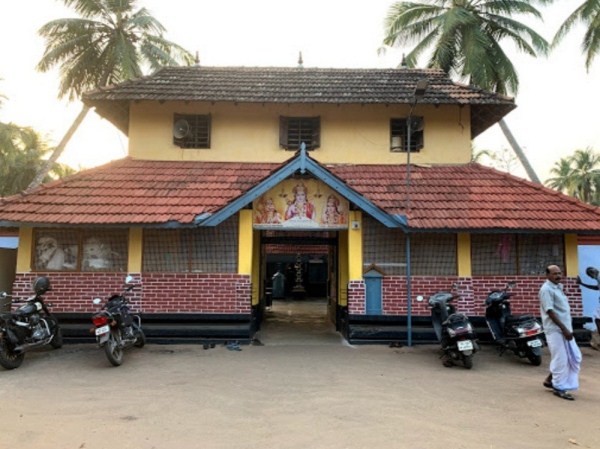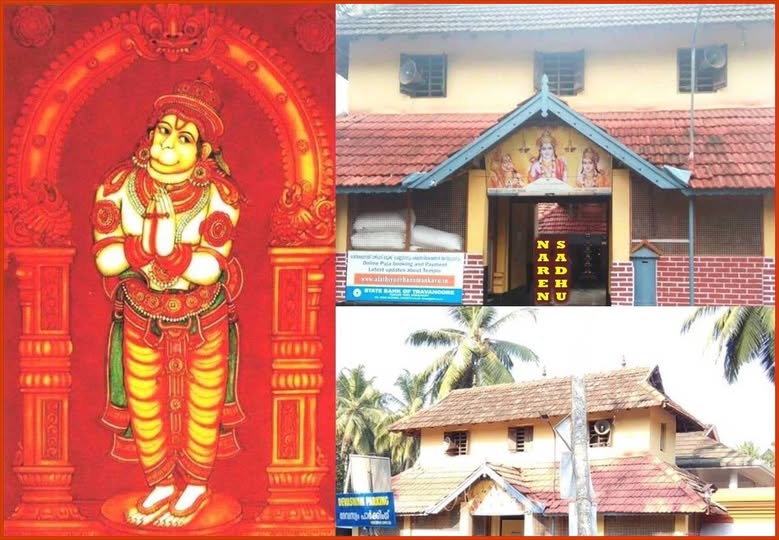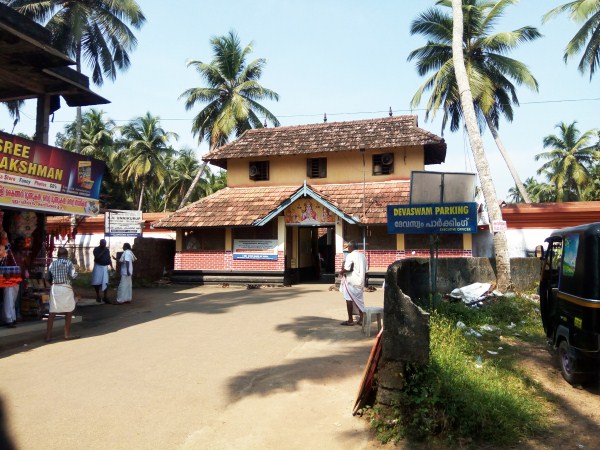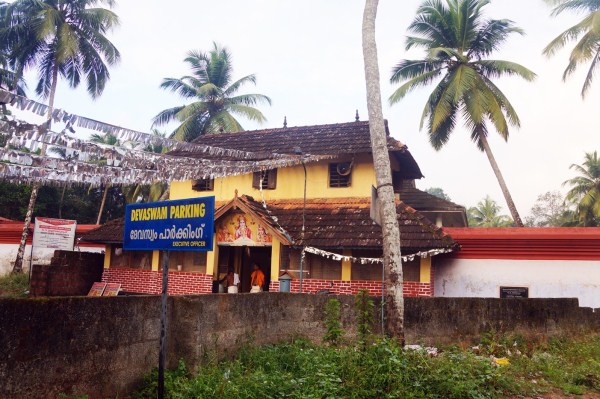Alathiyur Hanuman Temple, also known as Alathiyur Perumthrikkovil or Hanuman Kavu, is a renowned Hindu temple situated between the Ponnani River and the Bharathappuzha at Alathiyur, near Tirur in Malappuram district, Kerala.

Though Lord Rama, the seventh avatar of Vishnu, is the principal deity, the temple is equally famous for Lord Hanuman, who is believed to be an incarnation of Shiva, a devout follower of Rama, and one of the immortal Chiranjivis.
In addition to Rama and Hanuman, the temple houses sub-deities of equal reverence, including Lakshmana, Ganesha, Maha Vishnu, Durga, Bhadrakali, Ayyappan, and various Naga deities.
According to legend, the idol of Lord Hanuman was consecrated over 3000 years ago (around 1000 AD) by Sage Vasishtha, one of the revered Saptarishis.
Historically, the temple has been under the care of the Alathiyur village Nambudiri clan, the King of Vettathunad, and later the Samuthiri (Zamorin) of Kozhikode. The main offering at the temple is aval (flattened rice), a traditional prasadam.
The major annual festival is celebrated during the Thulam month (mid-October to mid-November), specifically on the days of the Pooradam, Uthradam, and Thiruvonam stars.
The temple also sees a large influx of devotees during the Karkidakam month (mid-July to mid-August), popularly known as the Ramayana month. Tuesdays, Thursdays, and Saturdays are considered especially auspicious for Hanuman worship and draw large crowds.
The temple is currently managed by a Trust under the Malabar Devaswom Board, with the Samuthiri royalty serving as the Chief Trustee. It is regarded as one of the most important temples under the administration of the Malabar Devaswom Board. Although Lord Rama is the main deity of the Alathiyur temple, it is popularly known as the Hanuman Temple due to the deep devotion and prominence given to Lord Hanuman here.
According to legend, it was at this sacred spot that Rama gave crucial instructions and guidance to Hanuman before his leap to Lanka in search of Sita.
The idol of Hanuman is placed beside that of Rama, depicted in a unique posture—leaning forward attentively, as if listening intently to Lord Rama’s words, with a staff (gada) in his hand. A separate shrine for Lakshmana is located a few meters away, signifying that Lakshmana respectfully stood aside to allow Rama and Hanuman a private moment of discussion.
An iconic structure at the temple commemorates Hanuman’s mighty leap across the ocean. At one end of this structure lies a large black stone, symbolizing the sea. Devotees often run along this platform and leap over the black stone, a ritual believed to bring blessings of good luck, health, long life, and prosperity.
Devotees strongly believe that Hanuman at Alathiyur not only removes fears and sorrows but also grants the heartfelt wishes of his devotees. Alathiyur Temple is situated near Alathiyur village, facing east. In front of the temple, a row of small shops caters to the needs of devotees. The temple’s entrance is quite narrow, which makes it challenging for large vehicles to pass through. For convenience, a designated parking area is available on the northeastern side of the temple.
To the north of the main Gopuram (entrance tower) lies the temple tank—a spacious and serene water body where both priests and devotees traditionally bathe before entering the temple for worship. Near the tank stands a small Peepal tree, regarded as sacred in Hinduism.
According to belief, Brahma resides at the top of the tree, Vishnu in the middle, and Shiva at the roots. Devotees believe that circumambulating the tree seven times in the morning promotes health and well-being.
Also found near the temple is a Cluster fig tree. The village name “Alathiyur” is believed to have originated from a combination of the names of these trees—‘Aal’ (ആൽ, Peepal tree), ‘Athi’ (അത്തി, Cluster fig), and ‘Oor’ (ഊർ, meaning village). These two trees are part of the famous Nalpamaram (നാല്പാമരം)—a group of four trees widely used in Ayurvedic medicine.
On the eastern side stands a dilapidated two-story tower, showing signs of age and decay. Atop the Gopuram is a plaque displaying the divine figures of Lord Rama, Lord Hanuman, and Lakshmana, symbolizing the sacred essence of the temple.
If one enters the temple through the eastern corridor, the first structure that comes into view is the elephant enclosure. This relatively large structure is a recent addition to the temple complex. Notably, the temple does not have a flagstaff, as no flag-hoisting festival (Kodiyettam) is conducted here—though plans are underway to install one in the future.
A prominent altar (Balikkal Pura) is situated directly in front of the sanctum of Lord Rama. This central altar, though elevated, is constructed slightly lower than usual so that devotees can have a clear view of the deity from outside the sanctum. Above the altar hangs an image of Lord Hanuman, reinforcing his close association with Lord Rama. On the southern side of the altar, a small door can be found.
This door is aligned toward Hanuman's feet and is specifically designed for those who are unable to enter the inner sanctum to pay their respects.
The offerings and donation collection office is located toward the southeastern side of the temple premises. Among the most important offerings at the temple are Palpayasam (milk pudding) to Lord Rama and Aval (flattened rice) to Lord Hanuman. These nivedyams are considered highly sacred, and many devotees present them in hopes of having their wishes fulfilled. Offerings are made in various traditional measurements such as 1 nazhi, 50 nazhi, or 100 nazhi (nazhi being an ancient unit used in Kerala to measure volume, approximately equal to 312 millilitres).
There have been media reports suggesting that the late Tamil Nadu Chief Minister J. Jayalalithaa was a devotee of this temple and had made offerings seeking favourable outcomes in legal cases involving her.
Right next to the offerings counter is a small shrine dedicated to Lord Vishnu. According to local tradition, this idol originally belonged to the Irani Temple in nearby Kalpakancheri village but was relocated to Alathiyur due to certain local circumstances. Though it is a Vishnu idol, the deity is worshipped in the form of Sri Krishna and faces west. The sanctum sanctorum of the Alathiyur Temple, locally known as the Srikovil, is housed within a large, two-story square structure. Both floors of this granite shrine are clad in copper, lending it a distinctive and traditional appearance.
Crowning the structure is a golden dome that glistens in the sunlight, enhancing the sanctity and visual grandeur of the temple.
Inside the Srikovil, there are three chambers. The innermost chamber, the Garbhagriha, where the main deity is installed, is located at the western end. Here, Lord Rama is worshipped in the form of a four-armed Vishnu idol, approximately five feet tall, facing east. Though the idol is sculpted from black stone, it is covered with Panchaloha (a sacred alloy of five metals). The deity holds the Sudarshana Chakra in the rear right hand, the Panchajanya conch in the rear left, the Kaumodaki mace in the front left, and a lotus flower in the front right hand.
This form is a conceptual representation of Rama during his solitary quest for Sita, and as such, there is no shrine for Sita within the Srikovil.
The shrine dedicated to Lord Hanuman is a separate structure built to the south of the main sanctum. The idol of Hanuman here is about three feet tall, depicted in a standing posture with both hands folded in reverence, facing slightly to the left. This posture is believed to symbolize Hanuman intently listening to Rama's instructions before setting out for Lanka.
The interior of the Srikovil is adorned with beautiful murals and sculptures, which, while not ancient, are remarkable in detail and artistry.
These murals primarily depict key episodes from the Ramayana, such as the birth of Rama, Sita’s Swayamvara, Jatayu Moksha (liberation), and Hanuman in the Kadalivanam (Ashoka forest). Among all these, one of the most significant artworks is that of Goddess Bhadrakali with eight arms.
A legend associated with this image recounts that a priest once served both the Alathiyur Temple and the famed Bhagavati temple at Kapalathinkal nearby. Struggling to manage rituals at both temples, the priest prayed to the Goddess for her constant presence at Alathiyur. In response to his devotion, the presence of Bhadrakali was believed to have manifested at the Alathiyur Temple—thus her divine image found a place in the sanctum.
Hanuman shrine at Alathiyur Temple, located adjacent to the main sanctum of Sree Rama, depicts a powerful and symbolic moment from the Ramayana—Hanuman stands with a mace in hand, his head slightly tilted towards Rama, listening intently as his master confides in him the sacred Abhignana Vaakyam, the cue-word that would help him gain Sita’s trust in Lanka. This posture captures Hanuman's divine qualities—immense strength, focused purpose, unwavering devotion, humility, and supreme self-sacrifice. Infused with power from the gods, Hanuman is shown ready to embark on his mission, silently affirming to Rama, “Your wish is my command.” In alignment with the Ramayana narrative, Lakshmana is positioned away from them, ensuring the cue-word remains confidential. Devotees throng to this temple to seek blessings from this divine listener and messenger, believing that their prayers will be heard and fulfilled by the ever-compassionate Hanuman.
ആലത്തിയൂർ പെരുംതൃക്കോവിൽ ശ്രീരാമ-ഹനുമാൻ ക്ഷേത്രം
മലപ്പുറം ജില്ലയിലെ തിരൂരിനടുത്ത്, പൊന്നാനിപ്പുഴയ്ക്കും ഭാരതപ്പുഴയ്ക്കും നടുവിലാണ് സ്ഥിതി ചെയ്യുന്ന ആലത്തിയൂർ ഒരു പ്രശസ്തമായ തീർത്ഥാടനകേന്ദ്രമാണ്. ഇവിടെ സ്ഥിതിചെയ്യുന്നത് ആലത്തിയൂർ പെരുംതൃക്കോവിൽ ശ്രീരാമ-ഹനുമാൻ ക്ഷേത്രമാണ്, പൊതുവേ ആലത്തിയൂർ ഹനുമാൻ കാവ് എന്ന പേരിലാണ് ഈ ക്ഷേത്രം അറിയപ്പെടുന്നത്. വിഷ്ണുവിന്റെ ഏഴാമത്തെ അവതാരമായ ശ്രീരാമചന്ദ്രനാണ് പ്രധാന പ്രതിഷ്ഠയായിട്ടുള്ളത് എങ്കിലും, ശ്രീരാമഭക്തനായ ഹനുമാനാണ് ക്ഷേത്രത്തിലെ പ്രധാന പൂജയും ആരാധനയും ലഭിക്കുന്നത്. കൂടാതെ, ശ്രീലക്ഷ്മണൻ, ഗണപതി, മഹാവിഷ്ണു, ദുർഗ്ഗ, ഭദ്രകാളി, അയ്യപ്പൻ, നാഗദേവതകൾ എന്നിവയും ഉപദേവതകളായി ഇവിടെ കുടികൊള്ളുന്നു.
ഐതിഹ്യപ്രകാരം, ഹനുമാന്റെ പ്രതിഷ്ഠ 3000 വർഷങ്ങൾക്ക് മുൻപായി (ക്രി.പു. 1000) വസിഷ്ഠ മഹർഷി നിർവഹിച്ചു എന്നാണ് വിശ്വാസം. ക്ഷേത്രത്തിന്റെ ആദി പരിപാലകരായിരുന്നവർ ആലത്തിയൂർ ഗ്രാമ നമ്പൂതിരിമാർ, തുടർന്ന് വെട്ടത്ത് രാജാവ്, പിന്നീടു കോഴിക്കോട് സാമൂതിരി രാജാവ് എന്നിവരായിരുന്നു. പ്രധാന വഴിപാട് അവൽ നിവേദ്യമാണ്. തുലാമാസത്തിലെ പൂരാടം, ഉത്രാടം, തിരുവോണം നക്ഷത്രദിവസങ്ങളിലാണ് പ്രധാന ഉത്സവം നടത്തുന്നത്. കർക്കടകമാസം, രാമായണമാസം എന്നറിയപ്പെടുന്ന ഈ കാലഘട്ടം ക്ഷേത്രത്തിൽ വലിയ തിരക്കുണ്ടാകുന്ന കാലമാണ്. അതോടൊപ്പം, ഹനുമാനെ ആസ്വദിക്കുന്ന ചൊവ്വ, വ്യാഴം, ശനി ദിവസങ്ങൾ തീർത്ഥാടകരിൽ പ്രത്യേക വിശേഷമുള്ള ദിവസങ്ങളായി കണക്കാക്കപ്പെടുന്നു. സമസ്ത ക്ഷേത്രഭരണം മലബാർ ദേവസ്വം ബോർഡിന്റെ കീഴിലാണുള്ളത്, സാമൂതിരി രാജാവ് മുഖ്യ കാര്യദർശിയായിട്ടുള്ള ഒരു ട്രസ്റ്റാണ് എല്ലാ പ്രവർത്തനങ്ങളും മേൽനോട്ടം വഹിക്കുന്നത്.
ശ്രീരാമന്റെ വിഗ്രഹത്തിന് സമീപത്താണ് ഹനുമാന്റെ വിഗ്രഹം സ്ഥാപിച്ചിരിക്കുന്നത്. ഹനുമാൻ കൈയിൽ ദണ്ഡം പിടിച്ച് ശ്രീരാമന്റെ വചനങ്ങൾ കേൾക്കാനായി തലചായ്ക്കുകയും മുൻപോട്ടു ചാഞ്ഞ നിലയിലാണ്. ലക്ഷ്മണന്റെ ക്ഷേത്രം കുറച്ച് ദൂരെ തന്നെയാണ് സ്ഥിതി ചെയ്യുന്നത്, ഹനുമാനെയും ശ്രീരാമനെയും സ്വകാര്യമായി സംസാരിക്കാനായി ലക്ഷ്മണൻ അകലെയായിരുന്നുവെന്ന് ഐതിഹ്യം പറയുന്നു. ഹനുമാന്റെ കടൽ ചാടി ലങ്കയിലേയ്ക്കുള്ള കുതിപ്പ് അനുസ്മരിപ്പിക്കുന്നതായും ധൈര്യത്തിന്റെയും ശക്തിയുടെയും ചിഹ്നമായി ഒരു തിട്ട ഈ ക്ഷേത്രത്തിൽ ഒരുക്കിയിട്ടുണ്ട്. തിട്ടയുടെ ഒരു അറ്റത്ത് കടലിന്റെ പ്രതീകമായി ഒരു വലിയ കരിങ്കല്ല് സ്ഥാപിച്ചിട്ടുണ്ട്. ഭക്തർ ഈ തിട്ടയിലൂടെ ഓടി കരിങ്കല്ലിനു മുകളിലൂടെ ചാടുന്നു. ഈ ചാട്ടം ഭാഗ്യവും ആരോഗ്യവും ദീർഘായുസ്സും സമൃദ്ധിയും നൽകുമെന്ന് വിശ്വസിക്കപ്പെടുന്നു. വിശ്വാസികളുടെ ദുഃഖങ്ങൾ, ആശങ്കകൾ എന്നിവ നീക്കി, അവരുടെ മോഹങ്ങളും ആഗ്രഹങ്ങളും പൂർണ്ണമാക്കുന്ന ഹനുമാൻശക്തി ആലത്തിയൂരിൽ പ്രത്യക്ഷമാണെന്ന് വിശ്വസിക്കുന്നു.
ക്ഷേത്രത്തിന്റെ വടക്കുഭാഗത്താണ് ശ്രീരാമാനുജനായ ലക്ഷ്മണസ്വാമിയുടെ ക്ഷേത്രം സ്ഥിതിചെയ്യുന്നത്. ഇവിടെ ലക്ഷ്മണൻ ഉപദേവനായി മാത്രം അല്ല, ശ്രീരാമനോട് തുല്യപ്രാധാന്യം ഉള്ള പ്രതിഷ്ഠയായി ആരാധിക്കപ്പെടുന്നു. ശ്രീരാമൻ ഹനുമാനോട് സീതയെ കണ്ടെത്താനായുള്ള രഹസ്യവാക്യം പറഞ്ഞു കൊടുക്കുമ്പോൾ, അത് കേൾക്കാതിരിക്കാൻ ലക്ഷ്മണൻ പുറത്ത് മാറിനിന്നുവെന്ന ഐതിഹ്യത്തെ അടിസ്ഥാനമാക്കിയാണിത് നാലമ്പലത്തിന് പുറത്തായി സ്ഥാപിക്കപ്പെട്ടിരിക്കുന്നത്. ചതുർഭുജ മഹാവിഷ്ണുരൂപത്തിലാണ് ആദിശേഷാവതാരമായ ലക്ഷ്മണന്റെ പ്രതിഷ്ഠ, കിഴക്കോട്ട് ദർശനമുള്ള ചെമ്പുമേഞ്ഞ ചെറിയ ചതുരശ്രീകോവിലിൽ വച്ചാണ് ഈ പ്രതിഷ്ഠ. മുൻവശത്ത് ചെറിയൊരു നമസ്കാരമണ്ഡപവും നിർമ്മിച്ചിരിക്കുന്നു. ശ്രീകോവിലിന്റെ തെക്കുഭാഗത്ത് ഒരു ഗണപതിപ്രതിഷ്ഠയുമുണ്ട്; അതിന് പിറകിലേക്ക് നാഗദേവതകളുടെ പ്രതിഷ്ഠയും കാണാം.
ലക്ഷ്മണസ്വാമിക്ക് പ്രത്യേകമായി വഴിപാട് സമർപ്പിക്കാനായി പ്രത്യേകം ഒരു കൗണ്ടറും ഒരുക്കിയിട്ടുണ്ട്. ഇവിടെ പ്രധാന നേർച്ചയും നിവേദ്യവും പാൽപ്പായസമാണ്. രണ്ടുനിലകളോടുകൂടിയ സാമാന്യ വലുപ്പമുള്ള ചതുരശ്രീകോവിലാണ് ഈ ക്ഷേത്രം. കരിങ്കല്ലിൽ നിർമ്മിതമായ ഇരുനിലയിലുള്ള ഈ ശ്രീകോവിലിന്റെ മുകളിലും താഴെയും ചെമ്പ് മേഞ്ഞിട്ടുണ്ട്, മുകളിൽ സ്വർണത്തിലും താഴികക്കുടവും ശോഭിക്കുന്നു. ശ്രീകോവിലിനകത്ത് മൂന്ന് മുറികളുണ്ട്, അവയിൽ പടിഞ്ഞാറേ അറ്റത്തുള്ളതാണ് ഗർഭഗൃഹം, എവിടെ ശ്രീരാമന്റെ വിഗ്രഹം പ്രതിഷ്ഠിച്ചിരിക്കുന്നു. ഈ വിഗ്രഹം ഏകദേശം അഞ്ചടി ഉയരം വരുന്ന ചതുർബാഹുവായ മഹാവിഷ്ണുവിഗ്രഹമാണ്, കിഴക്കോട്ട് ദർശനം. ഇത് കൃഷ്ണശിലയിൽ നിർമ്മിതമാണ്, എന്നാൽ പഞ്ചലോഹത്തിൽ ഗോളക ചാർത്തിയിട്ടുണ്ട്. ചതുർബാഹുവായ ഭഗവാന്റെ പുറകിലെ വലതുകയ്യിൽ സുദർശനചക്രവും, ഇടതുകയ്യിൽ പാഞ്ചജന്യശംഖും, മുന്നിലെ ഇടതുകയ്യിൽ കൗമോദകി ഗദയും, വലതുകയ്യിൽ താമരയും കാണാം.
ഈ വിഗ്രഹം സീതാന്വേഷണ സമയത്ത് വ്യത്യസ്തമായി, ശിരസ്സിൽ വിരഹത്തിലായ ശ്രീരാമനായാണ് പ്രതിഷ്ഠ ചെയ്യപ്പെട്ടിരിക്കുന്നത്. അതിനാൽ, ഇവിടെ സീതാദേവിയ്ക്ക് പ്രത്യേക പ്രതിഷ്ഠയില്ല.ശ്രീകോവിലിന്റെ തെക്കുഭാഗത്ത് ഹനുമാന്റെ പ്രതിഷ്ഠയാണ്. ഏകദേശം മൂന്നടി ഉയരം വരുന്ന ഹനുമാന്റെ വിഗ്രഹം, ഇരുകൈകളും കൂപ്പി ഇടത്തോട്ട് കാതുകോർപ്പിച്ച് നിൽക്കുന്ന രൂപത്തിലാണ്, ശ്രീരാമന്റെ ദൈവവാക്യങ്ങൾ കേൾക്കുന്ന രൂപമായി.ശ്രീകോവിൽ അതിമനോഹരമായ ചുവർച്ചിത്രങ്ങളും ദാരുശില്പങ്ങളും കൊണ്ട് അലങ്കൃതമാണ്, ഇവയിൽ പണ്ട് പഴക്കമില്ലാത്തതായി തോന്നിപ്പറയാം. പ്രധാനമായും രാമായണത്തിലെ ദൃശ്യമാർഗ്ഗങ്ങളിൽ നിന്നാണ് ഇവ ഉപയോഗിച്ചിരിക്കുന്നത്. ശ്രീരാമജനനം, സീതാസ്വയംവരം, ജടായു മോക്ഷം, കദളീവനത്തിലെ ഹനുമാൻ തുടങ്ങിയ വേഷങ്ങൾ പ്രധാനമാണ്.
ആലത്തിയൂർ പെരുംതൃക്കോവിൽ ശ്രീരാമ-ഹനുമാൻ ക്ഷേത്രം ഒരു മഹാക്ഷേത്രമാണ്, ഇവിടെ നിത്യേന മൂന്ന് പൂജകളും നടത്തപ്പെടുന്നു. പുലർച്ചെ നാലരയ്ക്ക് നാദസ്വരം, തവിൽ തുടങ്ങിയ വാദ്യങ്ങളോടെയും ഏഴുതവണ ശംഖു വിളിയോടെയും ഭഗവാനെ പള്ളിയുണർത്തിയശേഷം അഞ്ചുമണിയ്ക്ക് ക്ഷേത്രനട തുറക്കുന്നു. ആദ്യത്തെ ചടങ്ങ് നിർമ്മാല്യദർശനമാണ്, ശേഷം വിശദമായ അഭിഷേകങ്ങൾ നടത്തപ്പെടുന്നു, ഇതിൽ എണ്ണ, ജലം, വാകപ്പൊടി എന്നിവ ഉപയോഗിച്ച് വിഗ്രഹത്തിന് അഭിഷേകം നടക്കും. ആദ്യം ശർക്കര, കദളിപ്പഴം എന്നിവ സമർപ്പിച്ച ശേഷം, വിഗ്രഹം പൂമാലകളും സ്വർണ്ണ-രത്നാഭരണങ്ങളും ചന്ദനക്കൂട്ടും കൊണ്ട് അലങ്കരിക്കപ്പെടുന്നു. ആറുമണിയോടെ ഉഷഃപൂജയും, ഈ സമയത്ത് നെയ്പ്പായസം സമർപ്പിക്കുകയും, ഗണപതിഹോമവും നടത്തപ്പെടുന്നു.
തുടർന്ന് ഉപദേവതകൾക്കുള്ള പൂജകൾ ആരംഭിക്കുന്നു, ഹനുമാൻ സവാമിയ്ക്കുള്ള വിശേഷമായ അവിൽ പൂജകൾ രാവിലെ ഒമ്പതുമണിയോടെ ആരംഭിക്കും. പന്ത്രണ്ടുനാഴി പൂജയ്ക്ക് ശേഷം ഒമ്പതേകാലോടെ ഉച്ചപ്പൂജയും, പാൽപ്പായസം, ചതുശ്ശതം, വെള്ളനിവേദ്യം എന്നിവ സമർപ്പിക്കപ്പെടുന്നു. ഉച്ചപ്പൂജ കഴിഞ്ഞ് പതിനൊന്നുമണിയോടെ ക്ഷേത്രനട അടയ്ക്കുന്നു. വൈകീട്ട് അഞ്ചുമണിയോടെ നട തുറക്കുന്നതോടെ സന്ധ്യയ്ക്കുള്ള ദീപാരാധന നടത്തപ്പെടുന്നു, ഈ സമയത്ത് ക്ഷേത്രത്തിനകത്തും പുറത്തുമുള്ള ദീപങ്ങൾ കൊളുത്തിവച്ചിരിക്കും, കർപ്പൂരം ഉപയോഗിച്ചുള്ള ആരാധനയും നടക്കുന്നു.
ദീപാരാധന കഴിഞ്ഞ്, മേൽശാന്തി ഭക്തരെക്കൊണ്ട് കർപ്പൂരം ഉഴിയിയ്ക്കുകയും, പിന്നീട് രാത്രി ഏഴുമണിയോടെ അത്താഴപ്പൂജയും, അപ്പവും അടയുമാണ് പ്രധാന നിവേദ്യങ്ങൾ. അത്താഴപ്പൂജ കഴിഞ്ഞ്, ഏഴരമണിയോടെ വീണ്ടും നടയടയ്ക്കുന്നു. ആലത്തിയൂർ ക്ഷേത്രത്തിലെ ഏറ്റവും പ്രധാനപ്പെട്ട ആണ്ടുവിശേഷമാണ് തുലാമാസത്തിൽ പൂരാടം, ഉത്രാടം, തിരുവോണം നാളുകളിലായി നടത്തുന്ന തിരുവോണ മഹോത്സവം. ഈ മഹോത്സവം മൂന്ന് ദിവസങ്ങളോളം ആഘോഷിക്കപ്പെടുന്നു, വിശേഷാൽ പൂജകളും കലാപരിപാടികളും ക്ഷേത്രത്തിൽ നടത്തപ്പെടുന്നു.


